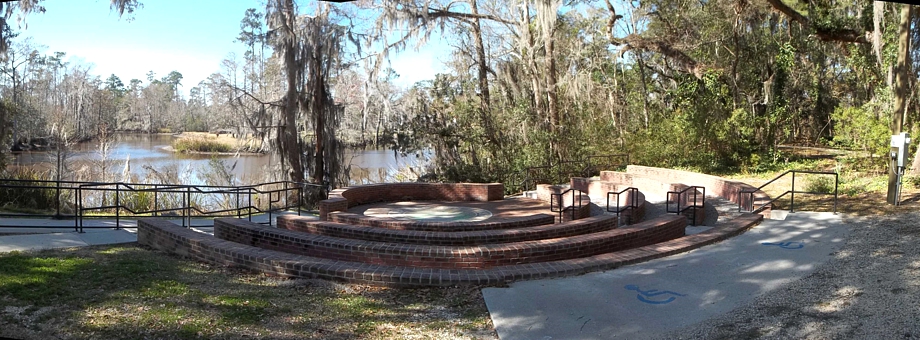
A HISTORY OF THE OLD TRADING POST AT CAMP SALMEN ON BAYOU LIBERTY
A Creole Cottage once called the Old Block House and now known as the Salmen Lodge.
Pre-History: The ocean receded from this area about two million years ago and local drainage, including Bayou
Liberty, was established. The bayou may have later been influenced by the nearby Pearl River when it brought large amounts of Ice Age melt-water, sand and gravel from up north that built up the “Camp
Ridge” part of the park.
Native American: A succession of peoples occupied the Gulf Coast for thousands of years including Paleo-Indians, Mississippian mound builders and more recently the Acolapissa and
Choctaw.
French era: Shortly after the French established their Louisiana colony in 1699, Bienville and his men stayed with the Acolapissa at nearby Bayou Castine in present-day
Mandeville. In 1720-30, shortly after New Orleans was founded, Bartram Jaffre (who called himself “La Liberte’”), Pierre Brou, Claude Vignon (who called himself “Lacombe”) and others were among
the first Europeans to settle along streams on the north shore of Lake Pontchartrain. They produced building materials (lumber, pitch, tar, shingles, and bricks), lime, charcoal, and farm products
which they sailed to the growing city across the lake.
Spanish era: Spanish Gov. Estivan Miro formally granted ownership of this land in 1787. New Orleans burned in 1788 and 1794 causing city government to decree all new
construction henceforth be of brick and mortar. This created a great economic opportunity for north shore producers of these building materials and resulted in much of today’s French Quarter being
made of north shore brick.
American era: Louisiana was acquired by the United States in 1803. It has been estimated that the brick core, original rear and front porches, floor and ceiling of the Old Trading
Post was built 1810-1830 by Joseph Laurent. He was involved in regular lake trade to and from north shore rivers and his schooner Marguerite (built on the Tchefuncte River) visited New Orleans’ port
on Bayou St. John in 1811 and several other occasions. He acquired this property in 1809 and probably
built the trading post using bricks and materials made on site. (By the time he sold the property to his business partner Francois Cousin in 1820 brick making on the property was well established as
noted on the property transfer.) The 1820 St. Tammany census lists Laurent, his wife, two young children and fifteen slaves, all of whom probably assisted him in his enterprises. He may have later
joined with several other individuals to found an academy in Covington in 1828.
The trading post was probably provisioned by regular visits from lake traders who transported locally produced goods from the bayou to the city and coast and brought needed supplies. Clients of the
trading post probably included local Choctaw as well as European and American settlers living up and down the bayou. A ferry was established near the building that joined three roads coming from the
east to a westward road on the other side. The community on Bayou Liberty came to be called “Bonfouca.”
The property changed hands several times until the Salmen Brick and Lumber Company acquired it in 1901 and used a railroad to extract the land’s timber and clay on an industrial scale. Salmen also
bought the ongoing store and ferry operation and used the building as a commissary for company workers. He donated the parcel to the Boy Scouts of the New Orleans area in 1924. In gratitude, they
named their new camp and its old trading post after him. The building was used for storage and as the camp director’s residence.
From the time of French settlement in the early 1700s and throughout the Nineteenth, Twentieth and into the Twenty-first Centuries, the Bonfouca community arose and thrived on the banks of Bayou
Liberty and was almost one and a half centuries old when the work camp for the new railroad between Meridian, MS and New Orleans, LA became the nearby town of Slidell in
1888.
CAMP SALMEN NATURE PARK
35122 Parish Pkwy.
Slidell, LA 70460
Office- 985-288-5901, Ranger – 985-502-2693
